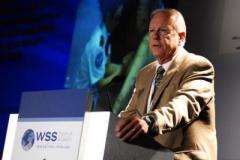Professor tracks Columbine media discourse from 'school shooting' to 'terrorism'

Decades spent studying mass media messages of fear led noted Arizona State University scholar David Altheide to examine how the Columbine High School shootings on April 20, 1999, were originally portrayed in the media and how those messages changed after 9/11 and leading up to the war in Iraq.
Altheide, a Regents' Professor of justice and social inquiry in ASU's School of Social Transformation, describes his findings in "The Columbine Shootings and the Discourse of Fear." His article will appear, along with others by noted scholars in the field, in a special two-part edition of the journal American Behavioral Scientist this April and May with the theme "Lessons of Columbine."
Previous shootings rarely used the word terrorism, except to imply that urban gangs were "terrorizing" communities. Altheide says that initially nearly every mass media account described the events at Columbine as a horrific school shooting. However, terrorism became more closely associated with Columbine after the 9/11 criminal attacks on the United States. Referring to the events as "terrorism" became an accepted way of describing the shootings in the media and linking them in a propaganda campaign to control enemies at home and abroad, he says. Indeed, on the fifth anniversary of the event in 2004, a writer for Slate online magazine, Dave Cullen, wrote: "The school served as means to a grander end, to terrorize the entire nation by attacking a symbol of American life." School policies began to change and students who even threatened school violence were increasingly being charged with terrorism.
"Before 9/11, most people would argue that school shootings weren't terrorism," says Altheide. "But after 9/11 it became credible that they were. People were willing to put these events under the umbrella of terrorism, al-Qaida and so much more - the term 'terrorism' became amorphous and all-inclusive." Altheide notes that a more accurate description supported by several studies is "rampage shooting."
In his article, Altheide contends that the extensive coverage and framing of the shootings as terrorist acts contributed to the broad discourse of fear as well as a more specific context for worrying about and protecting children, legitimating the war on terror and expanding social control. In the past, school administrators and local law enforcement entities handled such events. "Now federal agencies, including the FBI and Homeland Security, are involved," says Altheide. "Surveillance and other security tactics are employed and enhanced and our civil liberties are threatened. Everyone - child and adult - is seen both as a potential victim and suspect."
The methodology Altheide employed in his research began with a qualitative examination of news documents. He collected and analyzed data to follow certain issues, words, themes and frames over a period of time, across different issues and across different news media, an approach called "tracking discourse." This approach identifies key thematic shifts and focuses on trends over time. Beginning with a preliminary examination of several hundred newspaper reports, magazines and television transcripts that referred to Columbine in conjunction with other shootings, he then moved to an examination of print media coverage in four countries: the United States, Canada, New Zealand and Great Britain.
One of the lessons of Columbine is that casting school shootings within what Altheide calls a "mega frame" of terrorism can distort reality. "There was a concept developed in the social sciences 30 years ago called 'moral panic,'" Altheide says. "It was used when we overreacted to something, like drugs, by changing not only the law but also the social order. With terrorism, very few people suggest we might overreact with moral panic. That schools were dangerous places, vulnerable to terrorism, became a given." He states that schools are still very safe, but viewing them through a lens of fear - terrorism - can change how we treat students and approach other problems.
Source: Arizona State University (news : web)













